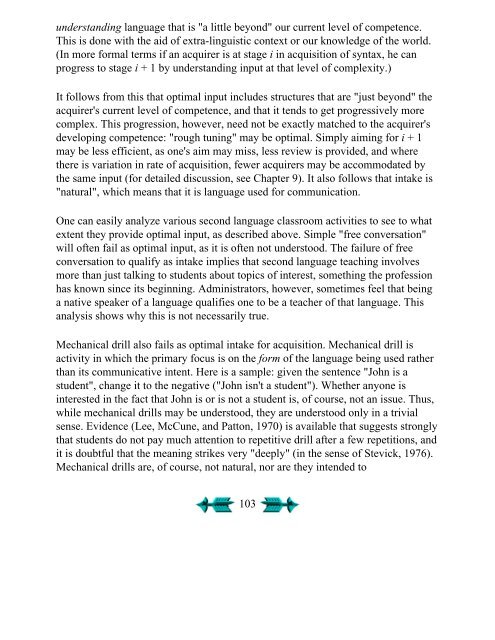Second Language Acquisition and Second ... - Stephen Krashen
Second Language Acquisition and Second ... - Stephen Krashen
Second Language Acquisition and Second ... - Stephen Krashen
You also want an ePaper? Increase the reach of your titles
YUMPU automatically turns print PDFs into web optimized ePapers that Google loves.
underst<strong>and</strong>ing language that is "a little beyond" our current level of competence.<br />
This is done with the aid of extra-linguistic context or our knowledge of the world.<br />
(In more formal terms if an acquirer is at stage i in acquisition of syntax, he can<br />
progress to stage i + 1 by underst<strong>and</strong>ing input at that level of complexity.)<br />
It follows from this that optimal input includes structures that are "just beyond" the<br />
acquirer's current level of competence, <strong>and</strong> that it tends to get progressively more<br />
complex. This progression, however, need not be exactly matched to the acquirer's<br />
developing competence: "rough tuning" may be optimal. Simply aiming for i + 1<br />
may be less efficient, as one's aim may miss, less review is provided, <strong>and</strong> where<br />
there is variation in rate of acquisition, fewer acquirers may be accommodated by<br />
the same input (for detailed discussion, see Chapter 9). It also follows that intake is<br />
"natural", which means that it is language used for communication.<br />
One can easily analyze various second language classroom activities to see to what<br />
extent they provide optimal input, as described above. Simple "free conversation"<br />
will often fail as optimal input, as it is often not understood. The failure of free<br />
conversation to qualify as intake implies that second language teaching involves<br />
more than just talking to students about topics of interest, something the profession<br />
has known since its beginning. Administrators, however, sometimes feel that being<br />
a native speaker of a language qualifies one to be a teacher of that language. This<br />
analysis shows why this is not necessarily true.<br />
Mechanical drill also fails as optimal intake for acquisition. Mechanical drill is<br />
activity in which the primary focus is on the form of the language being used rather<br />
than its communicative intent. Here is a sample: given the sentence "John is a<br />
student", change it to the negative ("John isn't a student"). Whether anyone is<br />
interested in the fact that John is or is not a student is, of course, not an issue. Thus,<br />
while mechanical drills may be understood, they are understood only in a trivial<br />
sense. Evidence (Lee, McCune, <strong>and</strong> Patton, 1970) is available that suggests strongly<br />
that students do not pay much attention to repetitive drill after a few repetitions, <strong>and</strong><br />
it is doubtful that the meaning strikes very "deeply" (in the sense of Stevick, 1976).<br />
Mechanical drills are, of course, not natural, nor are they intended to<br />
103











